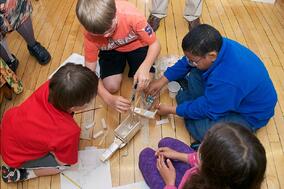 Building in-class time for small group work and labs can provide students with the opportunity to think critically and build hands-on knowledge in the STEM fields. Read on for 7 tips to maximize success!
Building in-class time for small group work and labs can provide students with the opportunity to think critically and build hands-on knowledge in the STEM fields. Read on for 7 tips to maximize success!
1. Group Intentionally
Forget the old days of counting off into random groups; successful small groupings are chosen with intention. Depending on your goals for the session, you can choose to mix ability level, or group similarly skilled students together in order to provide instructional support and enrichment.
2. Assign Roles
No matter how you group your students, be sure to assign clear roles for every member of the group. All students should feel like their contribution is necessary, and group members should feel accountable to one another to perform their role successfully.
3. Draw Real-World Connections
Students typically take their small group more seriously if the task is linked to a real-world issue. Push students to consider how teams work together in the sciences, city government, and private firms. By prompting students to position their work in a larger context, you can foster leadership skills and forge connections between their coursework and the pressing problems facing real-world communities.
4. Clarify Expected Outcomes
Before students begin work, clearly communicate the criteria you'll use to measure their success. Provide models of excellent student work to give students a clear, measurable target to shoot for. Remember: you want students to think deeply and come up with their own ideas, but give them clear guidelines so that they know what type of final product is expected of them.
5. Let Students Try
If your students have the basics of the scientific or engineering design process down, consider giving them more responsibility. Set up a question or a problem and let them work their way through the next steps of the process, even constructing their own model prototypes and experiments depending on the length of your class. This is a great way to help students develop critical thinking with independent multimodal learning opportunities. Just be sure to provide students with clear expectations and time to reflect on the connections between STEM practices and the question or problem as a group at different stages throughout the class.
6. Test Equipment
If you're using technology or other lab equipment, be sure to test it thoroughly before each small group session. Go over procedures for use before students begin, and be sure to build in ample time to set up and clean up equipment. A brand new set of fully loaded iPads in a classroom simply won't add any value if both teacher and students are unclear how to use them in an academic setting. Be careful not to assume your students will automatically know how to work technology, and also...
7. Have a Plan B
Power outages happen. Equipment can break. Keep a few emergency activities in mind to keep a small group lesson rolling if your set-up fails to work in the way you so carefully planned. Remember, the key to group work is getting students engaged meaningfully in the content, and a well-planned session should be able to do just that, no batteries required.





